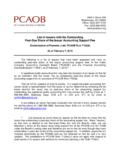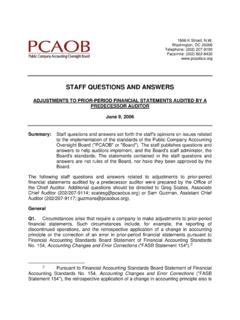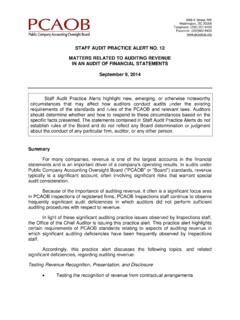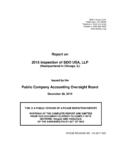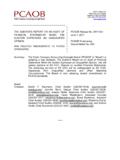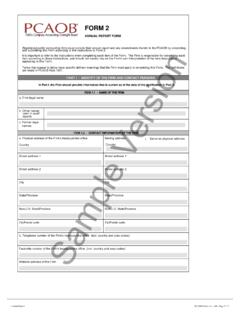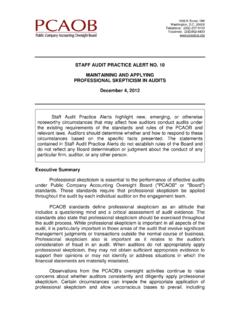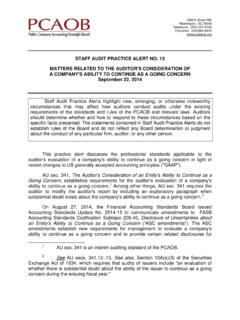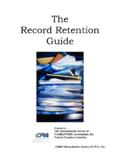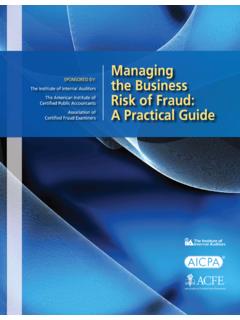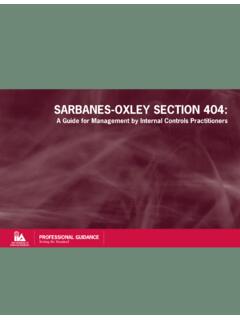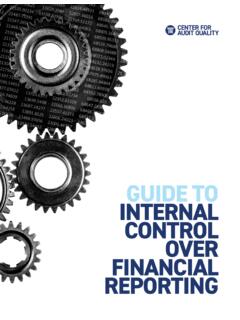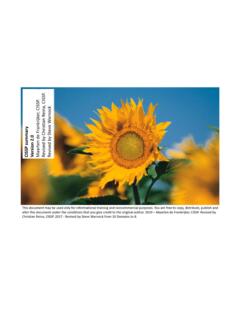Transcription of INTERNAL CONTROL OVER FINANCIAL REPORTING (ICFR)
1 A LAY P E R S O N S GUIDE TO INTERNAL CONTROL over FINANCIAL REPORTING (ICFR) Prepared by Kayla J. Gillan, Member of the Public Company Accounting Oversight Board For The Council of Institutional Investors Annual Spring Meeting March 31, 2006 The views expressed in this document are those of the author s, and do not necessarily reflect the position of the PCAOB, its other Board members, or its staff. i TABLE OF CONTENTS Page WHAT IS INTERNAL CONTROL over FINANCIAL REPORTING (ICFR)? 1 WHAT IS A MATERIAL WEAKNESS IN ICFR? 2 WHAT DOES IT MEAN FOR A COMPANY TO HAVE A CLEAN AUDIT OF ITS FINANCIAL STATEMENTS, BUT DISCLOSE ONE OR MORE MATERIAL WEAKNESSES IN ICFR?
2 3 WHAT IS COMPANY MANAGEMENT S RESPONSIBILITY WITH REGARD TO ICFR? 4 WHAT IS THE INDEPENDENT AUDITOR S RESPONSIBILITY WITH REGARD TO ICFR? 5 HOW DOES THE TESTING PERFORMED DURING THE 404 PROCESS RELATE TO THE FINANCIAL STATEMENTS AUDIT? 6 CURRENT ISSUES 7 COST & BENEFIT CONSIDERATIONS 9 OPPORTUNITIES FOR INPUT 12 WHERE TO GO FOR MORE INFORMATION 13 APPENDIX 1.
3 REPRINT OF 404 OF THE ACT 16 2. EXCERPT OF 103 OF THE ACT 17 ii 1 WHAT IS INTERNAL CONTROL over FINANCIAL REPORTING (ICFR)? INTERNAL controls refer to those procedures within a company that are designed to reasonably ensure compliance with the company s policies. Under the framework developed in the early 1990s by the Committee on Sponsoring Organizations (COSO)1, there are three types of INTERNAL controls: Those that affect a company s operations Those that affect a company s compliance with laws and regulations Those that affect a company s FINANCIAL REPORTING Frequently, a CONTROL may address more than one of these objectives.
4 This paper focuses only on those controls that affect a company s FINANCIAL REPORTING ; this is also the sole focus of 404 of the sarbanes - oxley Act of 2002 (the Act). Under the COSO framework, there are five interrelated components of an effective INTERNAL CONTROL system; these are derived from the way the company is managed on a day-to-day basis: 1. The company s top-level environment with respect to CONTROL . This includes elements such as the ethical tone at the top, and the effectiveness of the board s audit committee in its high-level oversight of FINANCIAL REPORTING . This component is known as the CONTROL Environment. 2. The assessment of risks of the various processes and data points that feed into the company s FINANCIAL reports.
5 For example, a process that is highly susceptible to fraud would be considered to be a high-risk area. 3. The way in which controls are actually designed and implemented within the company, so as to address the identified risks. This component is known as CONTROL Activities. 4. The way in which information within the company is gathered and shared, both to people within the company responsible for FINANCIAL REPORTING , and to external users of FINANCIAL reports. This component is known as Information and Communication. 5. The way in which the effectiveness of these controls are monitored by company management. 1 COSO was formed in 1985 to sponsor the National Commission on Fraudulent FINANCIAL REPORTING (the Treadway Commission), and consists of organizations of FINANCIAL executives and auditors.
6 2 WHAT IS A MATERIAL WEAKNESS IN ICFR? A material weakness in ICFR exists if there is some flaw within the company s overall CONTROL system such that it is at least reasonably possible that a material misstatement in the company s FINANCIAL statements will not be prevented or corrected. Such a misstatement may occur on an annual basis (either before or after an audit [see question below]), or through interim FINANCIAL REPORTING ( , quarterly reports, which are un-audited). Examples may include inadequate segregation of duties ( , the person that receives commission from a sale also approves the loan agreement and reconciles the bank account); personnel lacking in sufficient accounting expertise to accurately prepare the FINANCIAL statements; and failure to reconcile significant account balances.
7 Under existing SEC and PCAOB rules, material weaknesses in ICFR must be publicly reported. Flaws in CONTROL systems that fall below material are reported within the company, either to company management or the audit committee (depending upon the severity of the flaw). In evaluating the severity of a flaw in ICFR, both auditors and companies look at two factors: the likelihood that the flaw will result in a FINANCIAL misstatement, and the magnitude of such an outcome. Thus, this process is, in essence, an exercise of risk analysis. For ICFR purposes, the meanings of reasonably possible and material rely upon long-established definitions of these same terms that exist with respect to accounting. However, experience gathered during the first year of implementing 404 and AS2 demonstrate that auditors and companies both had a difficult time applying these terms in this new context.
8 Like the generally accepted accounting principles (GAAP) that govern the preparation of FINANCIAL statements, there are no clear bright-line tests based solely on quantitative measures; qualitative measures must also be considered, and professional judgment is required. 3 WHAT DOES IT MEAN FOR A COMPANY TO HAVE A CLEAN AUDIT OF ITS FINANCIAL STATEMENTS, BUT DISCLOSE ONE OR MORE MATERIAL WEAKNESSES IN ICFR? When an independent auditor issues a clean opinion on the company s FINANCIAL statements, this is a representation to the public that the auditor has followed applicable auditing and related professional standards so as to allow the auditor to conclude with reasonable assurance that the FINANCIAL statements are fairly presented in conformity with GAAP in all material respects.
9 A clean audit opinion is not a guarantee of error-free financials, but is rather the conclusion by an auditor using procedures and professional judgment that are reasonable to the circumstances that the statements are fairly presented. But, neither the auditor nor the company is required to disclose whether the audit process itself revealed FINANCIAL statement errors that were corrected before the statements were filed with the SEC. The degree to which the auditor is involved in requiring management to correct FINANCIAL statements prior to their public filing is an indication of whether the company using only its own personnel (either employees or third party consultants) will produce FINANCIAL information that is materially accurate.
10 The ability of a company to accurately describe its own FINANCIAL condition is particularly relevant when the company discloses un-audited FINANCIAL information, as in quarterly reports filed with the SEC. Thus, while the audit of a company s FINANCIAL statements may be clean, this provides little information to those outside the company as to whether other FINANCIAL information is of similar reliability. One of the key purposes of 404 is to provide this additional information to market participants. Specifically, the ICFR audit report provides the public with a barometer against which to evaluate the reliability of a company s disclosed FINANCIAL information. Auditors follow certain professional standards (principally contained in PCAOB Auditing Standard No.)
